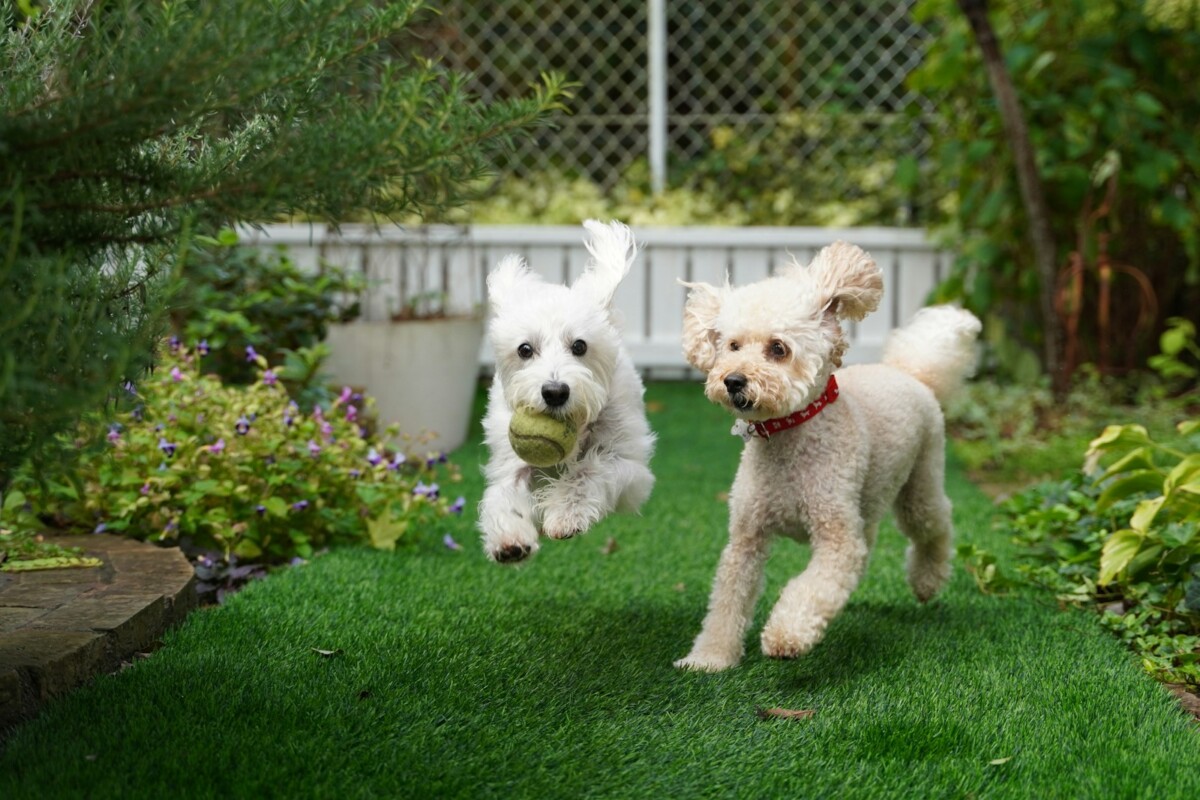If you share your home with a dog, the backyard isn’t just “outside”—it’s a stage for zoomies, sniffing, lazy sun naps, and the kind of mischief that makes you laugh later. This guide pulls together the best Dog-Friendly Backyard Ideas to turn your space into a safe, enriching hangout where you and your pup both want to spend time. Along the way, we’ll talk about backyard safety for dogs and smart pet-friendly landscaping choices, because style shouldn’t come at the expense of paws or peace of mind.
Below you’ll find idea blueprints (with why they work, how to build them, and safety notes). Mix and match them to fit your budget and yard size—tiny patios and sprawling lawns both apply. And yes, we’ll also slip in some practical tips on how to build a dog-friendly backyard on a budget without skimping on quality or durability.
1. Agility Training Zone
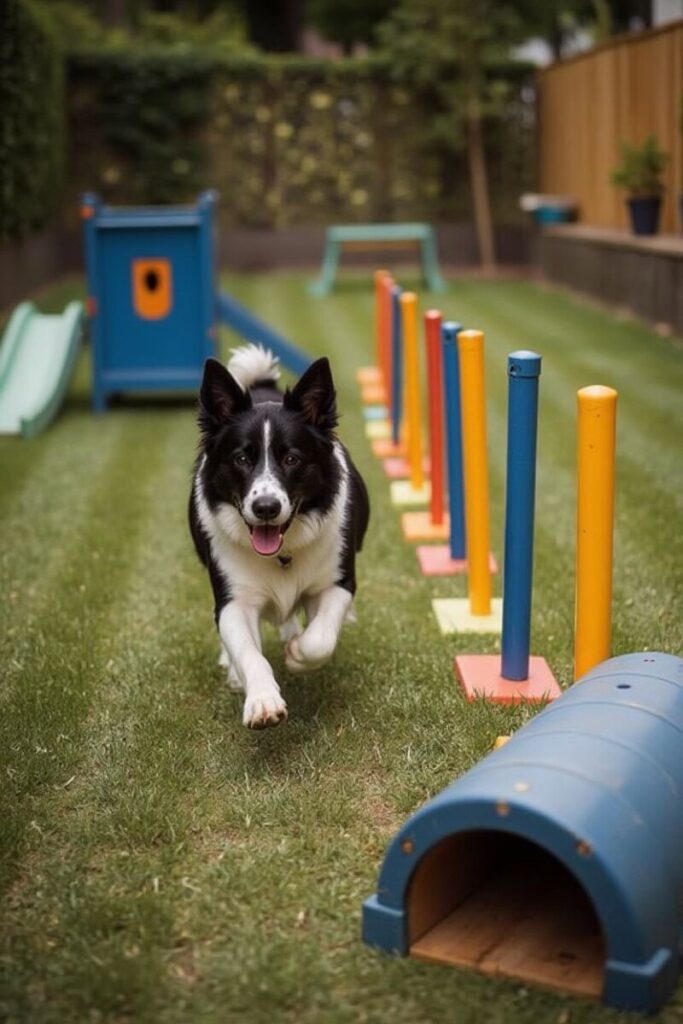
Think mini dog gym—but cute. Set up a simple course with weave poles, a low jump or two, and a tunnel. PVC poles, landscape flags, and a collapsible play tunnel are inexpensive and easy to store. Put the course on a flat area with non-slip footing: short grass, rubber tiles, or a sturdy outdoor rug.
For safety, keep jumps low (top of the dog’s elbow is a good rule), avoid slick surfaces, and space obstacles so your dog can approach straight—no tight turns at speed. Start slow. One success beats five rushed attempts.
Why it’s great: Agility builds confidence and burns energy, especially for smart, busy breeds. It also deepens the handler–dog bond (that’s you), and it looks tidy when arranged along a fence line.
Budget tip: DIY weave poles with ½-inch PVC and garden spikes. Paint them bright so both you and your dog read them easily.
2. Aromatic Herb Garden
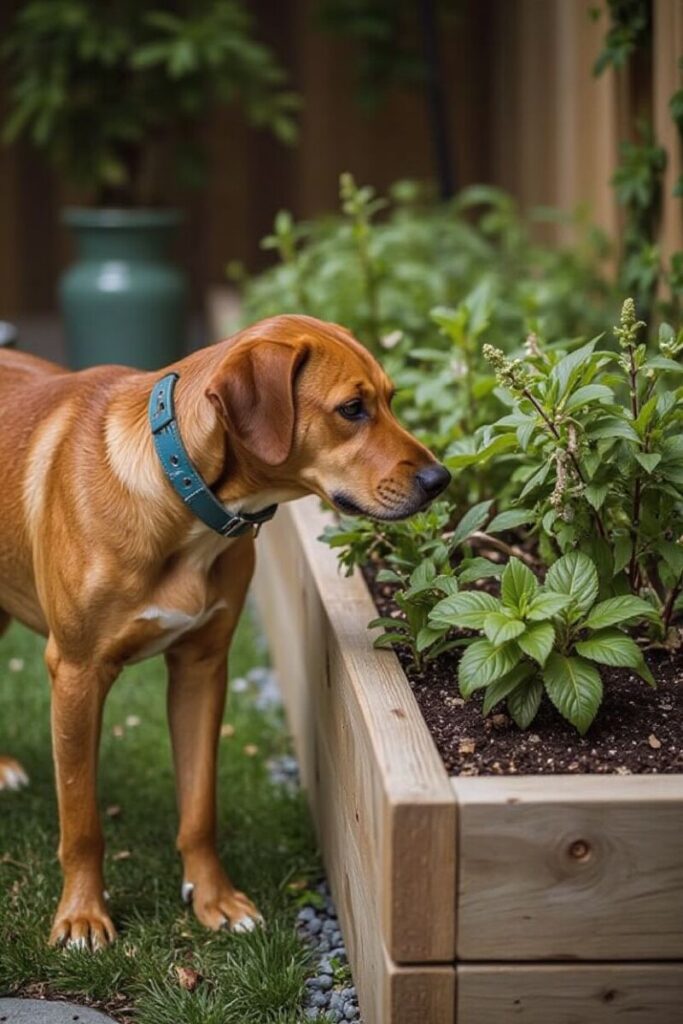
Dogs experience the world through their noses, so give them something delightful to sniff. Plant an aromatic bed near a walkway with dog-safe herbs like basil, thyme, parsley, dill, and rosemary (best as a brushing plant, not a snack). Add tall lavender for color and scent, but supervise dogs that like to chew; the fragrance is the main point here, not salad time.
Create simple raised beds using untreated cedar. Edge with smooth river stones so paws won’t snag. Mulch with shredded cedar (avoid cocoa mulch) to deter pests and keep moisture in.
Why it’s great: Scent exploration reduces stress. It’s enrichment that doesn’t require a toy—and it smells incredible when you brush by with a cup of coffee.
3. Backyard Water Park
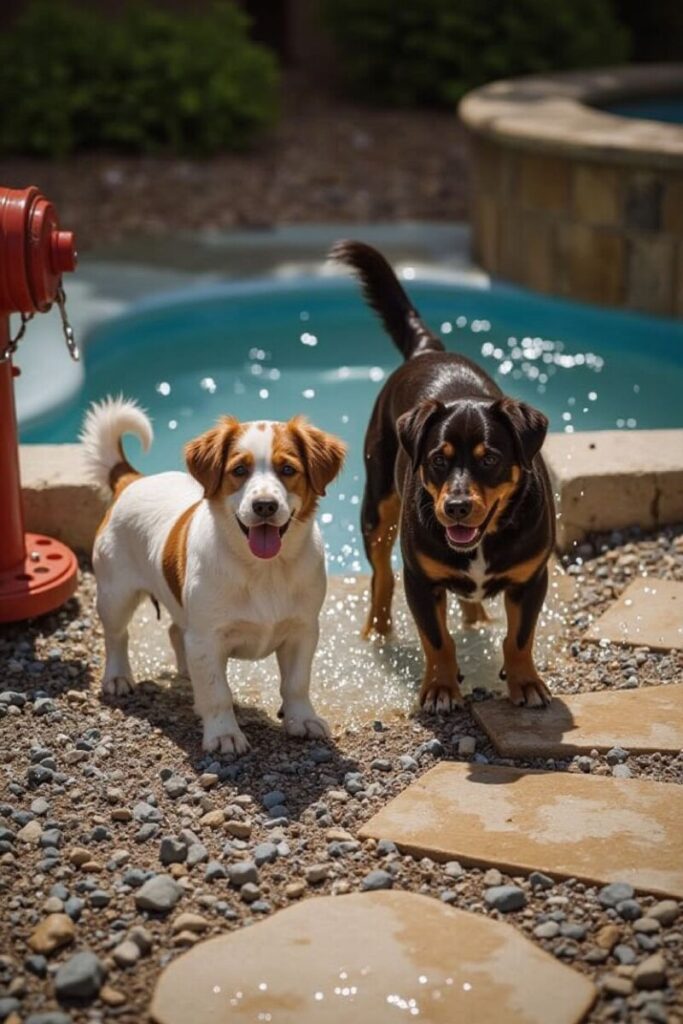
No, you don’t need a slide. A hose-free splash mat, oscillating sprinkler, and a shallow stock-tank “plunge pool” can turn the hot afternoon into playtime. Place everything on level ground; surround the area with non-slip pavers or pea gravel so wet paws have traction.
Sanitation matters. If you use a stock tank, add a drain valve for quick emptying and rinse daily in peak summer. Keep water under chest height for safety, and never leave dogs unsupervised when water is involved—ever.
Bonus: Set sprinklers on a timer so the fun shows up spontaneously, much like rain but less chaotic.
4. Comfortable Dog Lounger
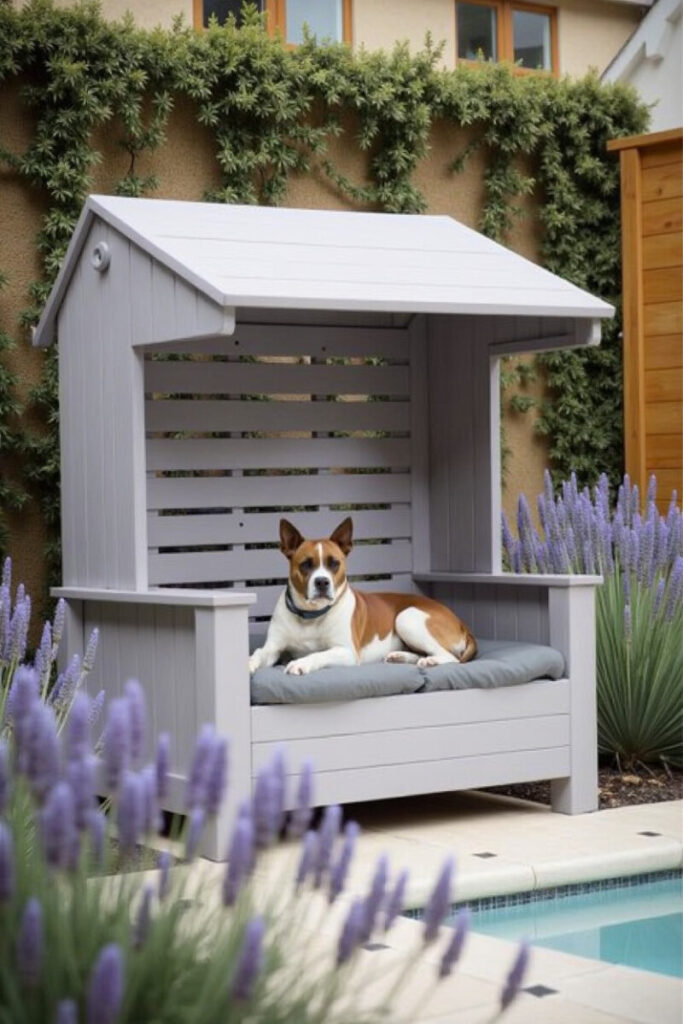
After the zoomies: lounge mode. Elevated cots keep bellies cool and dry, and outdoor cushions make napping look surprisingly elegant. Prioritize washable, UV-resistant fabrics. If your dog chews, skip piping and ties; choose tight-weave canvas instead.
Place the bed where you’d sit, too—dogs relax best in proximity to their people. A covered corner or next to the grill (but not too close) is ideal. Toss on a blanket for cooler evenings and you’ve built a habit loop: play, drink, nap, repeat.
5. Cozy Teepee
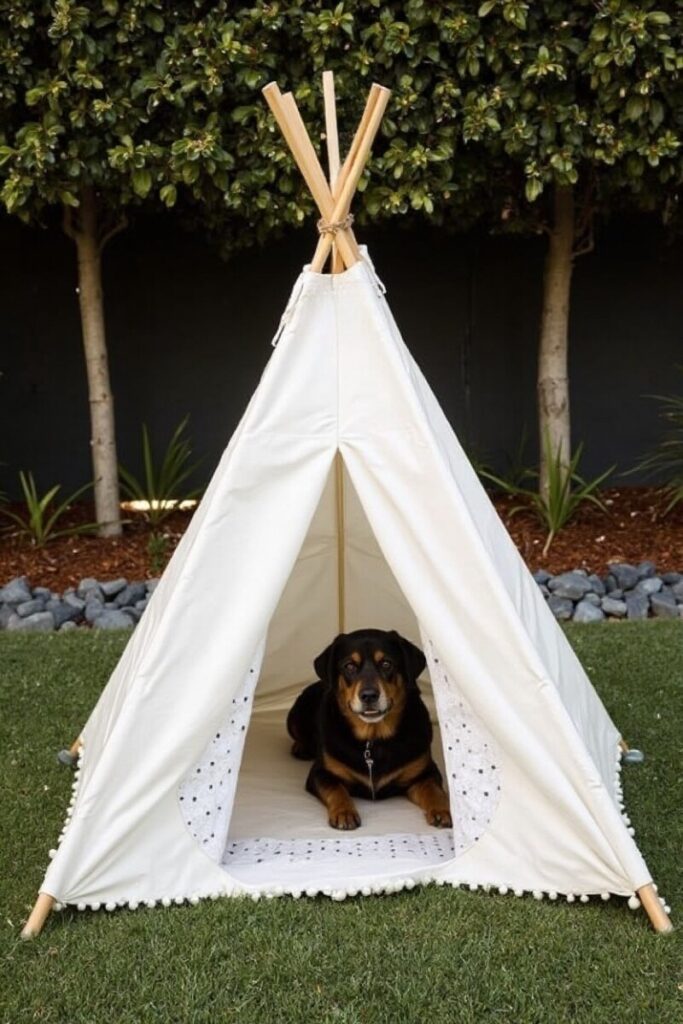
A small canvas teepee or pop-up tent gives your dog a den-like retreat. Add a low cushion and a couple of chew-safe toys. Secure the teepee with tent stakes so a gust of wind doesn’t send it bowling across the yard.
What it does: provides shade, reduces stimulation, and offers a “my spot” that can prevent resource guarding of furniture. It also looks whimsical enough to earn a place in family photos.
Cleaning is simple—most canvas covers hose off. Let it dry fully to avoid mildew.
6. Digging Pit Fun
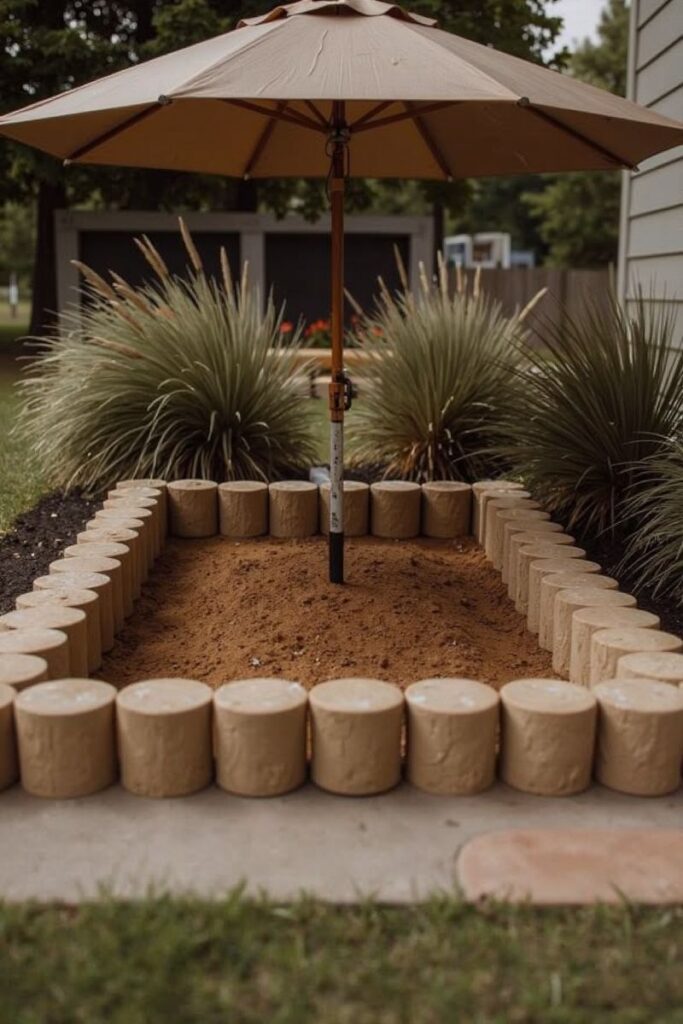
Digging is normal. Channel it. Build a dedicated dig box with untreated lumber, landscape fabric underlayment, and clean washed sand (or a sand-soil mix to reduce dust). Bury rubber toys or chews a few inches down to teach, “Dig here, not there.”
Edge the pit with logs or pavers so the boundary is obvious. If your dog flings sand with gusto, install a low, flexible border inside to catch most of it. Refresh the sand periodically and keep it dry to deter insects.
Cue it up: take your dog to the pit, say “Dig,” and celebrate when paws hit sand. When they tunnel in your flower beds, calmly redirect to their pit. It works—consistency is the trick.
7. Dog Lookout Platform
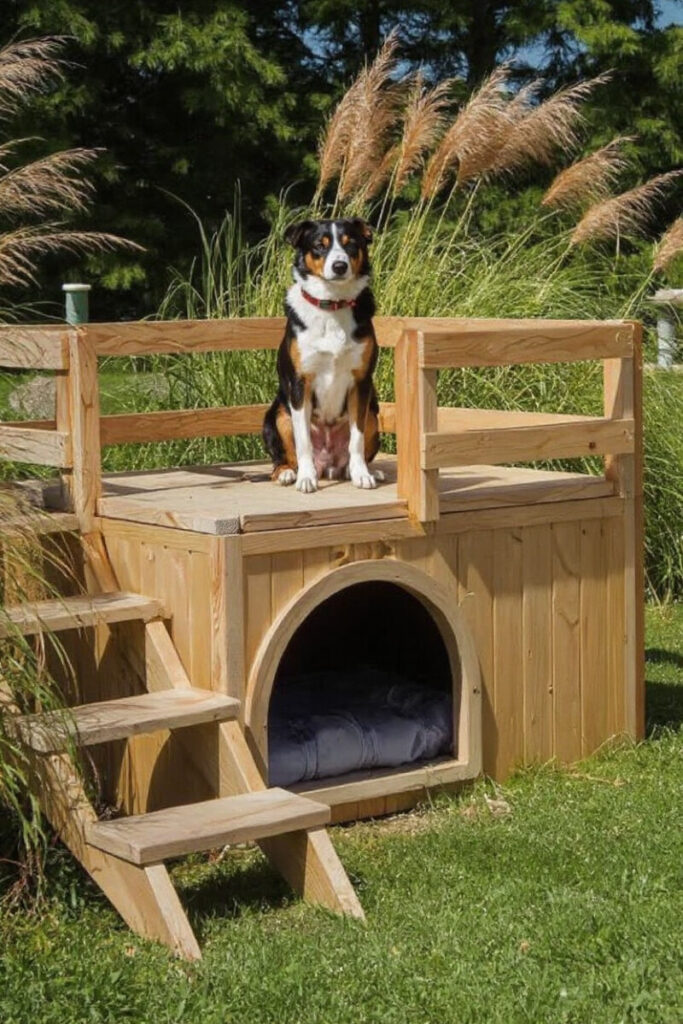
Dogs love a vantage point. A sturdy, low platform with a ramp or wide steps lets them survey the yard (and the suspicious squirrel). Build with pressure-treated lumber or composite decking, add a 3–4” lip or low railing, and use anti-slip tape on ramps.
Place it where there’s something to watch—near a fence line or facing the action of the house. Sun moves, so consider shade at midday; a removable sail overhead keeps the deck usable longer.
Behavior bonus: providing a “watch spot” can reduce fence running because the dog feels less compelled to patrol every inch.
8. Dog Playground
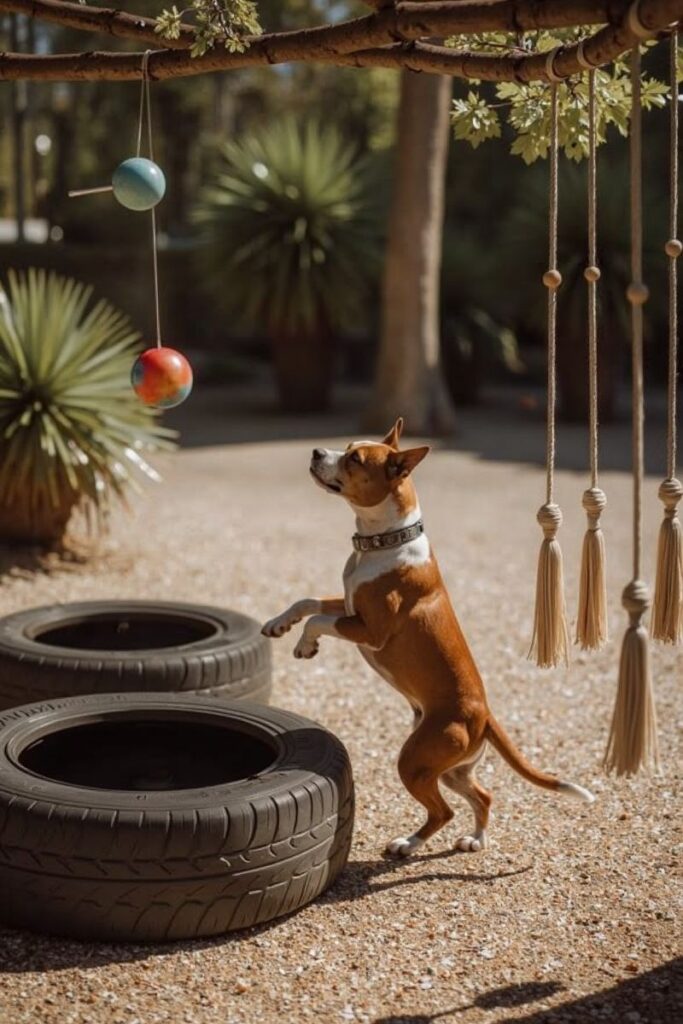
Blend movement and textures for a proper play zone: balance beams from landscape timbers, a couple of tire steps, a wobble board (plywood plus half-sphere base), and a swingy rope toy anchored overhead. Keep everything low—ankle-high to knee-high for most dogs—and test for wobble before inviting your pup aboard.
Ground the area with compacted fines or rubber mulch so falls stay soft. Rotate a piece every month so interest doesn’t fade. The playground shouldn’t feel like a gym class; it’s more like recess.
9. Durable Dog Grass
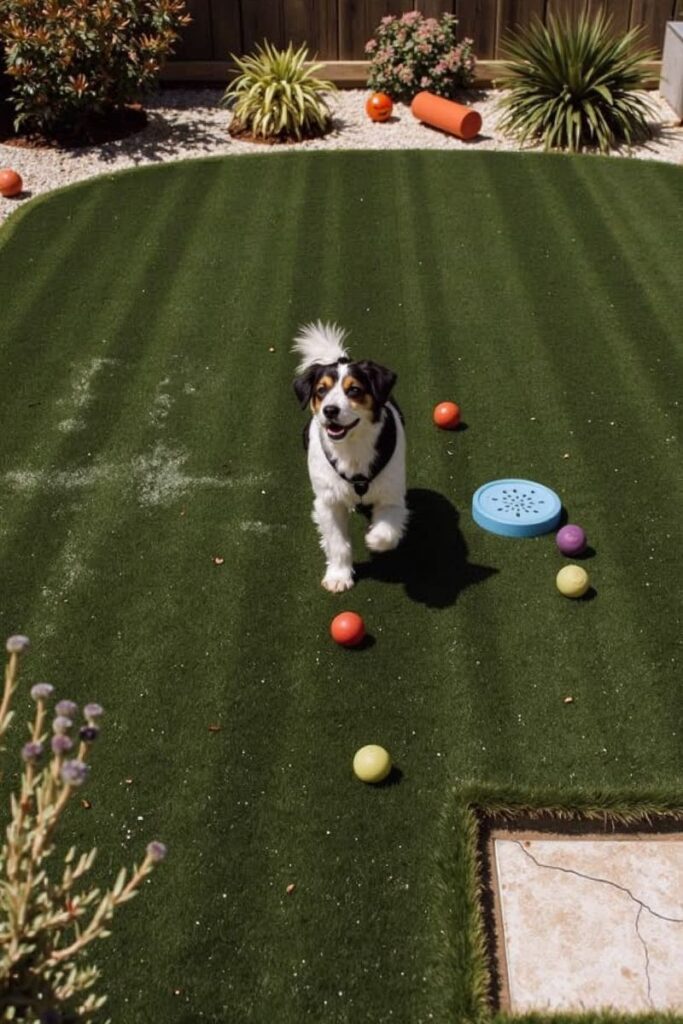
The dream: green, resilient, easy to rinse. You can choose hardy natural turf (tall fescue, Bermuda, or perennial rye blends) or high-quality dog turf designed for drains and paw traffic. If you go synthetic, install a proper base: compacted crushed rock, a deodorizing infill, and drainage that pulls moisture away from the surface.
Natural route? Overseed bare patches twice a year, raise mower height, and water deeply but not daily. Consider traffic lanes (dogs run racetracks); lay stepping stones through those “zoomie corridors” to spare your lawn.
Maintenance note: hose down after heavy use, especially in hot weather. A weekly enzyme spray keeps odors in check.
10. Edible Garden for Dogs

Plant snacks you both can share. Think blueberries, snap peas, carrots in a deep planter, and leafy greens like romaine. Herbs such as parsley and basil are fine; skip onions, chives, grapes, and anything you’re unsure about. When in doubt, plant in tall beds and treat “harvest time” as a supervised activity.
Why it works: picky eaters often try fresh garden peas straight from the vine—win. Plus, you’ll know exactly what went into that treat. Use fencing or low hurdles to protect seedlings; young plants are irresistible to curious noses.
11. Mini Flower Meadow
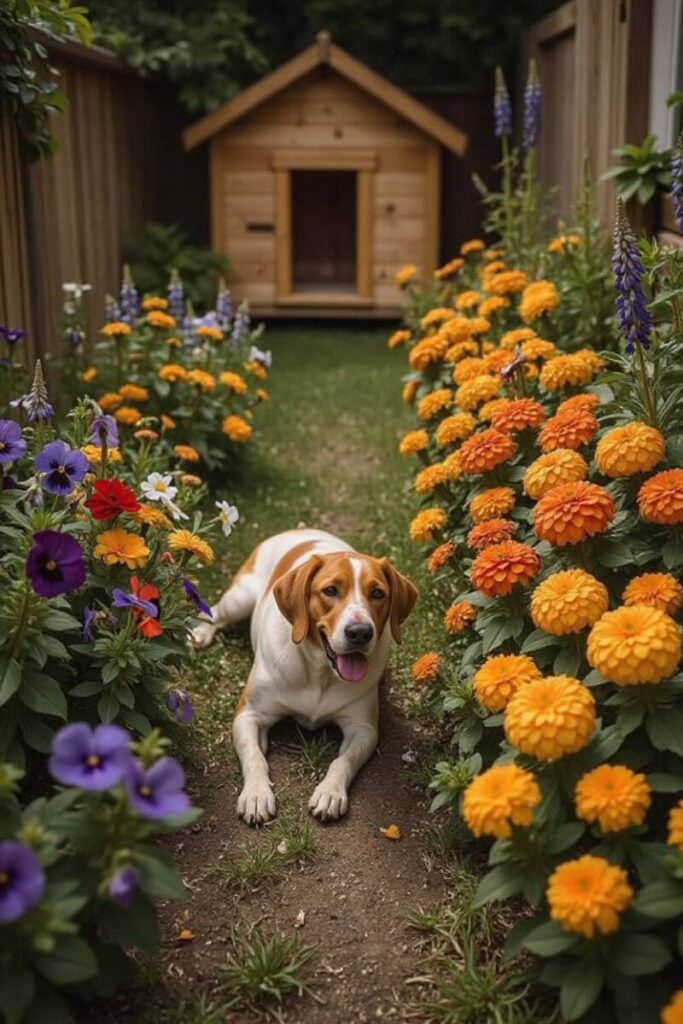
Swap a thirsty lawn corner for a dog-safe mini meadow. Marigolds, zinnias, calendula, and sunflowers (dwarf varieties) add color without inviting drama. Mix in native grasses for movement. Keep pathways mowed or graveled so your dog has a route—if you don’t provide one, they’ll make one anyway.
Training tip: teach a “through” cue and walk your dog along the paths so they learn to navigate without trampling flowers. And keep an eye out for bees; most dogs respect them, but excitement happens.
12. Multi-Pup Play Zone
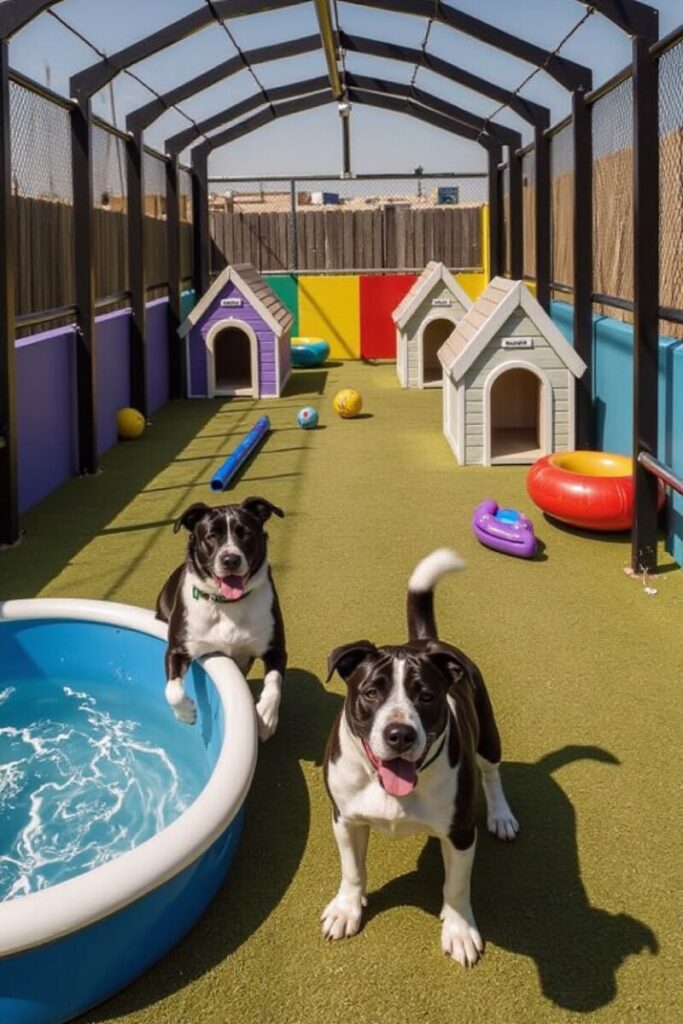
Two or more dogs need zones—fast lane for chasers, quiet corners for introverts. Create a ring path using pavers or compacted gravel so chasing doesn’t tear up turf. Add two water stations to prevent resource guarding. Shade each corner differently (tree canopy, sail, pergola) so dogs can choose their comfort level.
Toys? Few at once. Rotate daily. Multi-dog households do better when the environment is clear and predictable. Provide at least two rest spots and two exits for any narrow area so nobody feels trapped.
13. Pathways & Tunnels
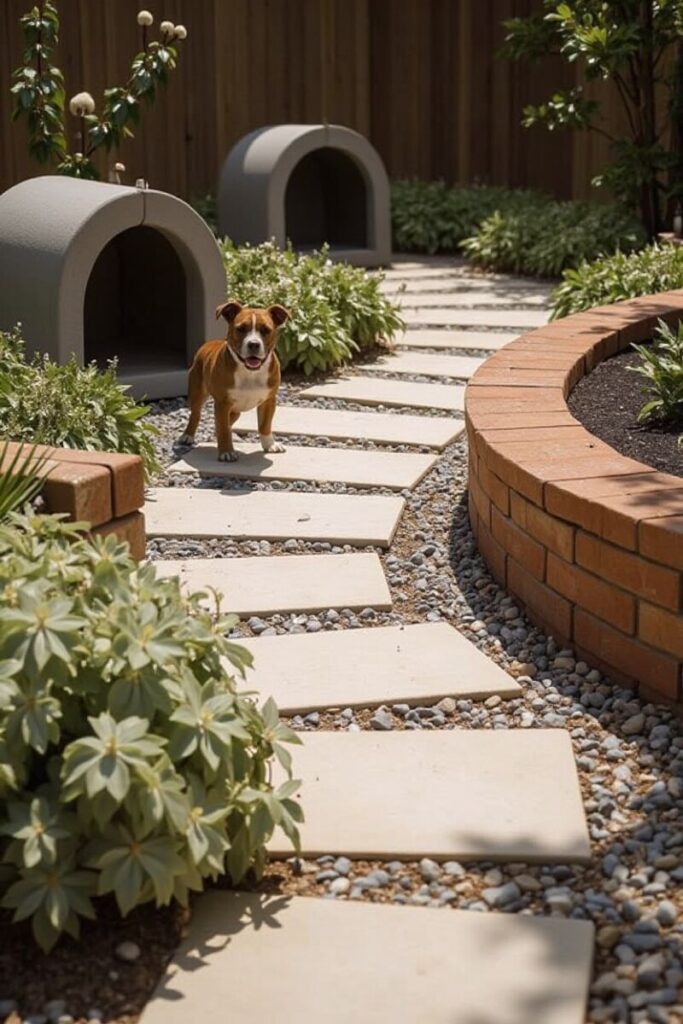
Dogs love routes. Build wide (at least 24”) paths with pea gravel, decomposed granite, or large stepping stones with groundcover between. Curves make the yard feel bigger and slow down running. For the “wow,” add a couple of safe tunnels—sturdy play tunnels or smooth concrete culverts with softened edges and enough diameter for your largest dog to move comfortably.
Safety first: avoid sharp-edged stone, and check tunnels on hot days (they can hold heat). Scatter a few raised planters along the path for visual interest and to subtly guide traffic.
14. Potty Area
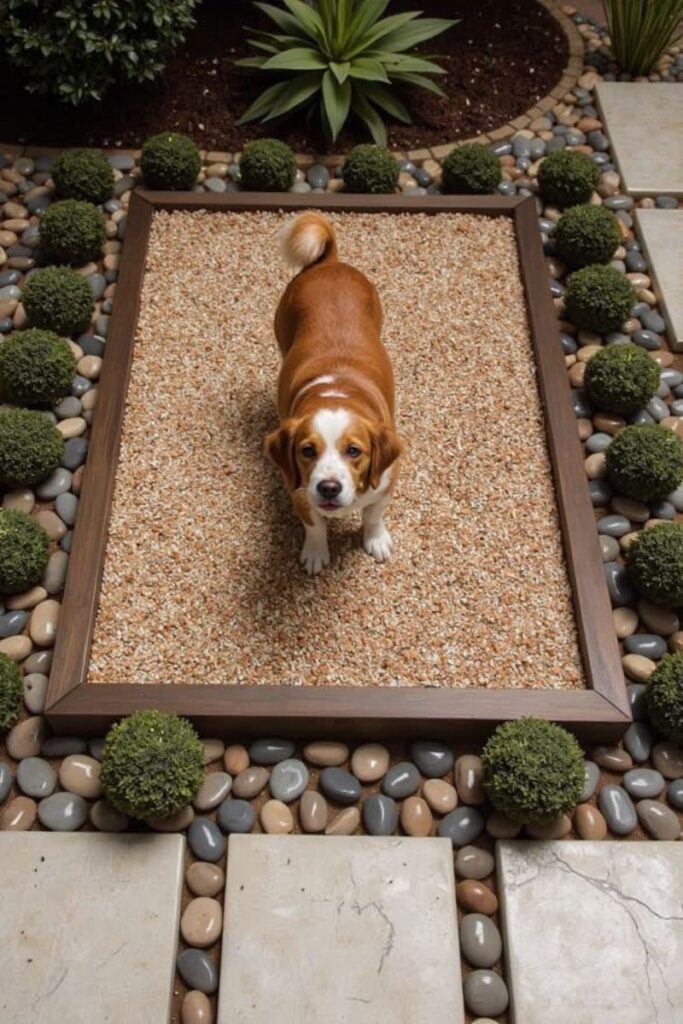
Designate a bathroom zone to keep the rest of the yard clean. Pea gravel drains well and rinses easily; decomposed granite also works, and some owners like permeable pavers with synthetic turf infill. Slight slope away from patios is key. Border it with a low fence, shrub line, or edging so the space reads clearly as “the restroom.”
Training is simple: leash to the spot, cue, reward, then release to play. Odor control: rinse daily in hot spells, use enzyme cleaner weekly. If you compost yard waste, keep poop out—it doesn’t belong there unless you have a dedicated pet waste system.
15. Pup Splash Zone
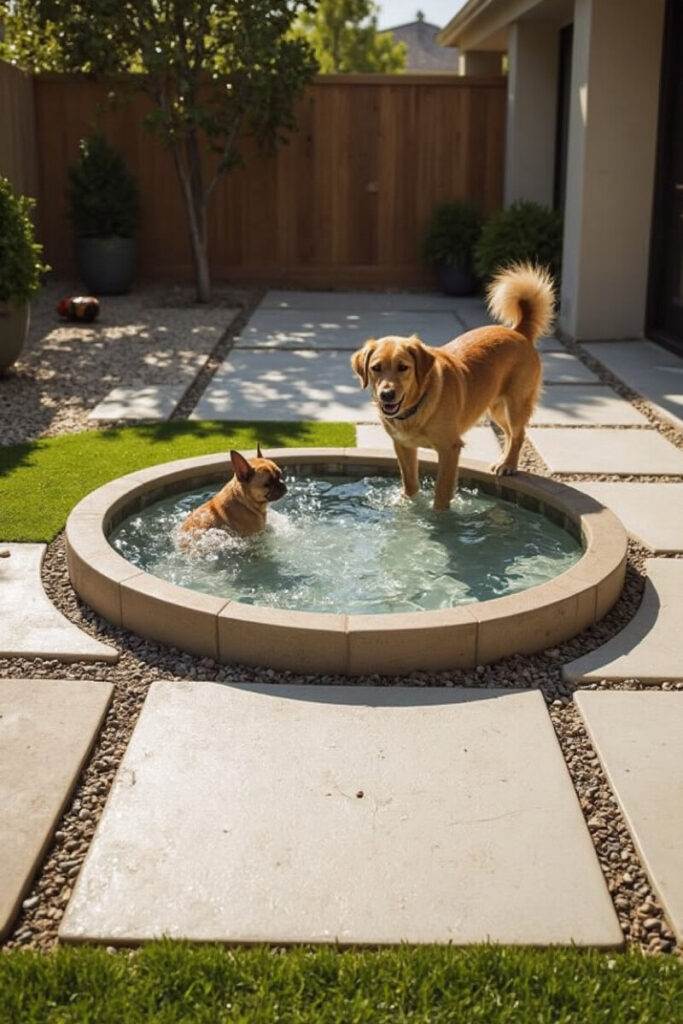
This is the quick-cool corner: a sturdy kiddie pool or low fountain bowl, a shade sail, and hooks for towels. Place it on a paver pad so muddy paws don’t track onto grass. Empty the pool after use—standing water invites mosquitoes and algae.
If your dog is new to water, toss in a floating toy and let them investigate at their pace. Never force it. Some will wade up to the ankles forever; fine by us. Hydration is the goal, not lap times.
16. Sensory Dog Garden
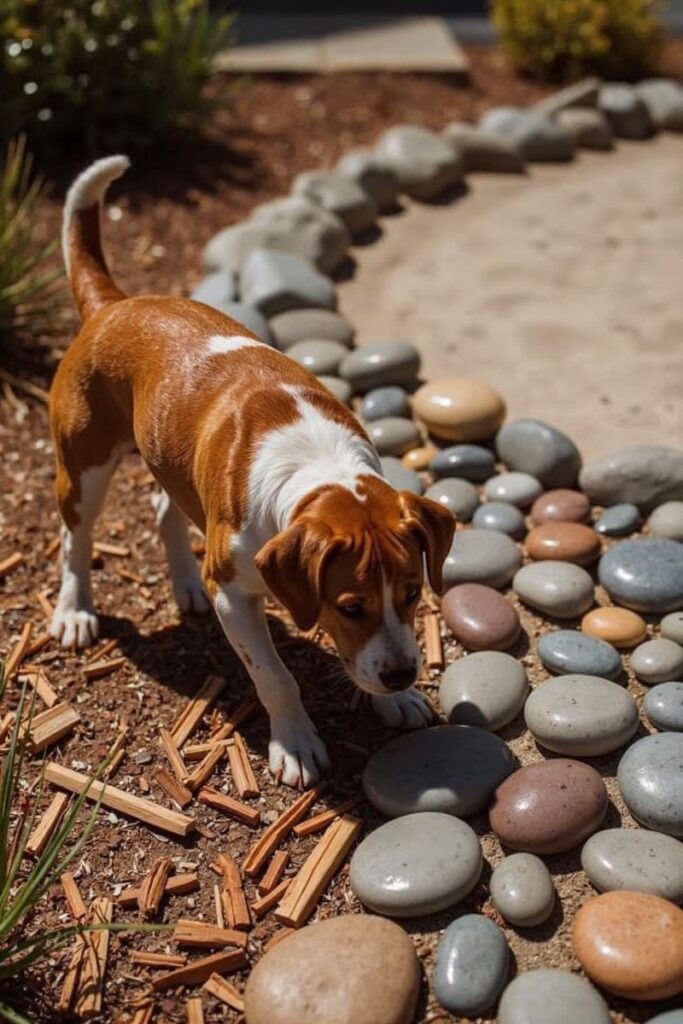
Layer experiences: rustling grasses, fragrant herbs, a bamboo chime, a snuffle bed made from outdoor doormats and fleece strips, and a “texture lane” of round river stones bordered by mulch. Hide a couple of treats in safe spots so the nose goes to work.
The sensory garden calms nervous dogs and tires out busy brains. Keep the sound elements gentle—wind chimes that clang loudly can spook sensitive pups. Rotate scents by pruning and rubbing foliage between your fingers now and then.
17. Shady Dog Retreat
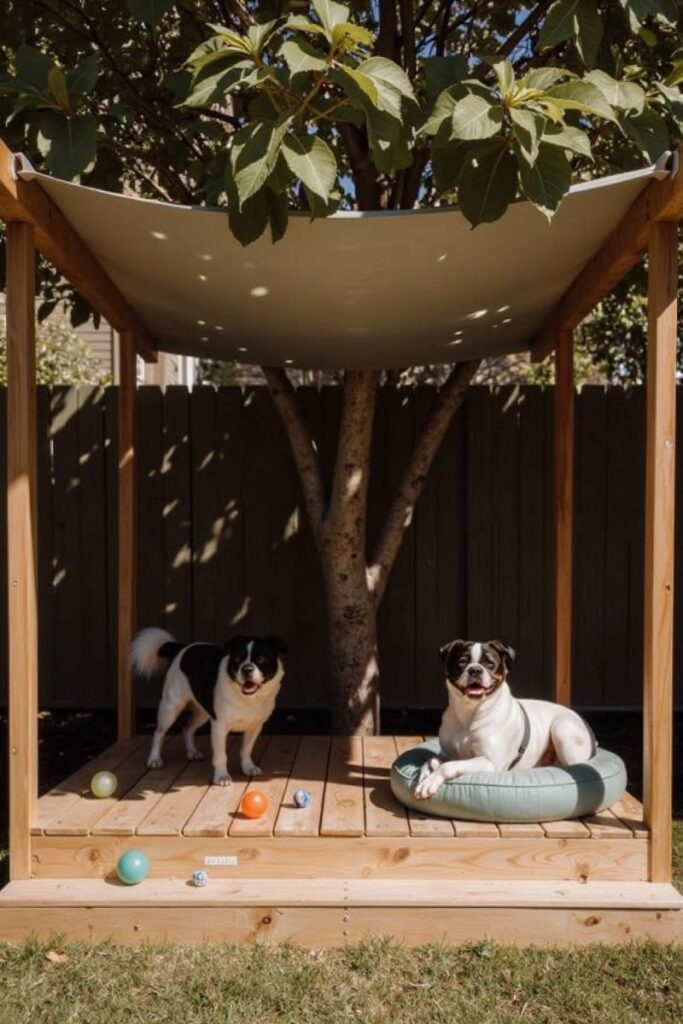
Shade is non-negotiable. Create a retreat with a pergola, tarp-style sail, or a leaf-dappled corner under a small tree (add a root-friendly deck platform to protect the tree). Place water nearby and a cot off the ground.
Heat safety: ground temps soar in summer. Test surfaces with your palm. If it’s too hot for you, it’s too hot for paws. Ventilate the retreat from three sides so breezes pass through, and consider a battery-powered fan on heat-wave days.
18. Soft Ground Cover
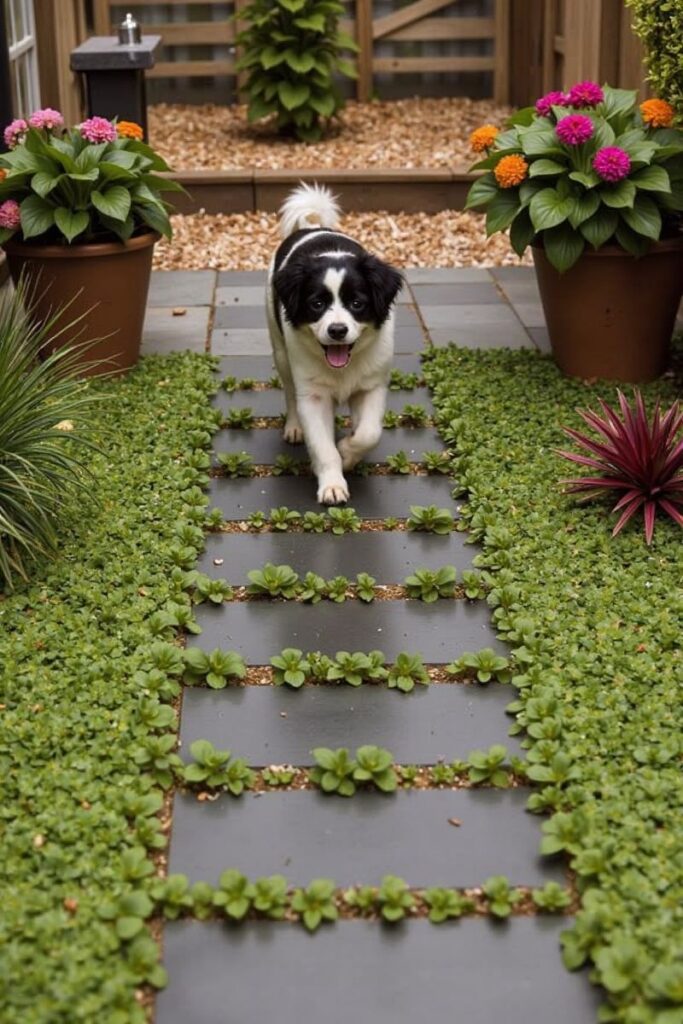
Some groundcovers shrug off traffic and feel nice underfoot. Creeping thyme, micro-clover, and tall fescue blends stay cooler than concrete and heal quickly after play. For mulch, choose shredded cedar or pine—not sharp bark shards—and keep depth shallow so dogs don’t sink and twist ankles.
If digging is your nemesis, look for the best ground cover for dogs that won’t dig as a trigger: micro-clover often satisfies the urge to nose around without inviting full-on excavation. Pair it with the dedicated digging pit (Idea #6) so your dog has a legal outlet.
19. Stone Path & Deck
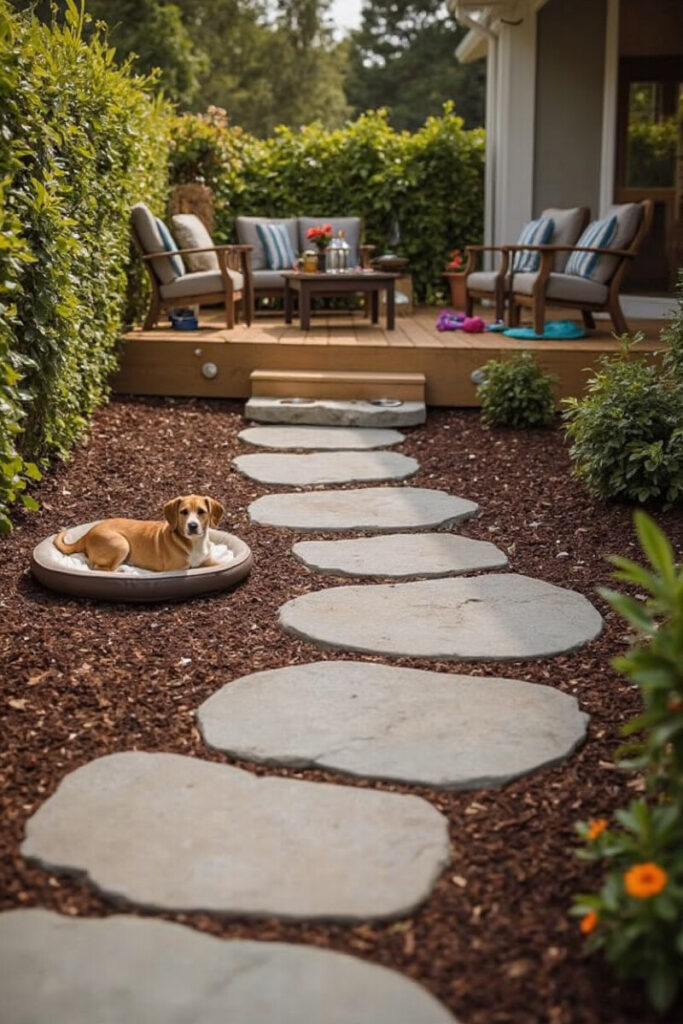
A path of large, flat stones set flush with surrounding soil offers traction and a clean look. Add a compact composite deck for your seating area—splinter-free and easy to rinse. Transition zones matter; use a strip of small pebbles or rubber edging where stone meets grass so paws don’t catch.
Make it accessible: wide steps, closed risers, and a gentle slope for seniors. At night, solar lights along the path help both humans and dogs see, and they make the yard feel resort-like without a single plane ticket.
20. Two-Story Doghouse
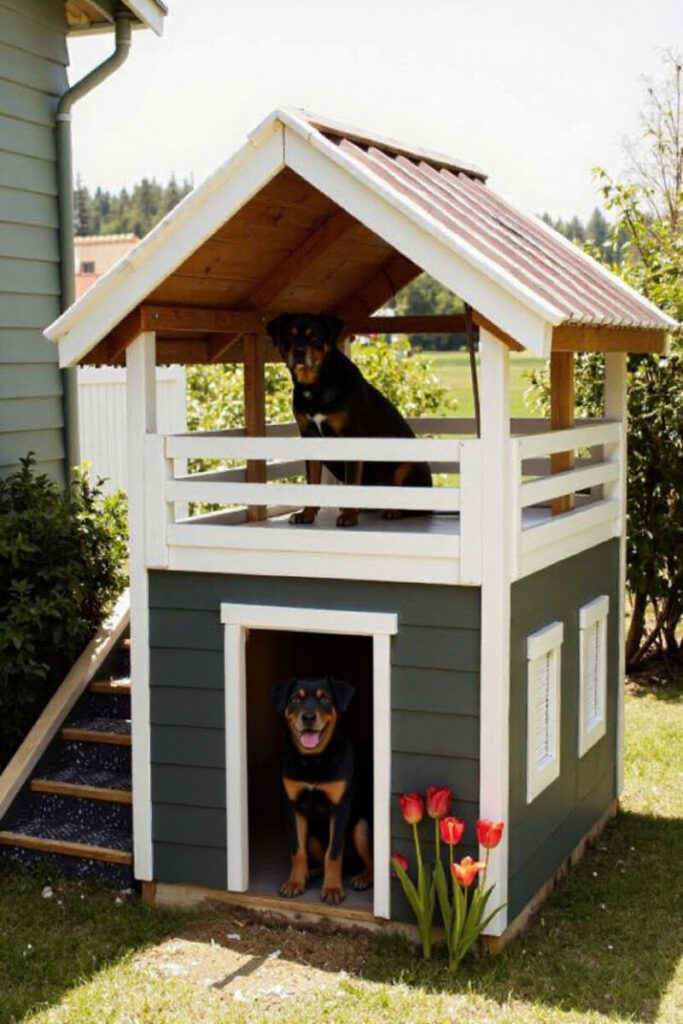
A two-level doghouse is part clubhouse, part lookout tower. Keep the footprint modest, the roof sloped, and the ventilation generous (vents at high and low points). The upper deck should have a solid rail or high lip. Insulate the lower den with foam panels sandwiched between plywood, and raise the whole structure a few inches on blocks to avoid damp.
Place it in dappled shade, not full sun, and choose a door with a soft flap or open arch depending on your climate. The panting test applies: if you sit inside and feel stuffy, it needs more airflow.
Planning Guide: Tie It All Together
Map the Zones: Dogs read yards as lanes and destinations. Identify the “fast lane” (fence lines), the “lounge lane” (near you), and the “business lane” (potty area). Put high-arousal activities—the agility course, splash pads—farther from your rest spot so energy flows outward.
Surface Strategy: Use at least two textures: one soft (grass or groundcover) and one utility (gravel or pavers). That mix controls mud, guides traffic, and keeps nails naturally worn.
Fencing & Gates: Six feet tall for jumpers, dig-proof footers for escape artists (12–18” buried wire, or L-footer along the inside). Self-closing gate hinges with a lock are worth every penny for backyard safety for dogs.
Shade & Water: Every active zone should be within a quick trot of water and shade. On small patios, a single umbrella can pull double duty. On large lots, duplicate stations so dogs don’t have to compete.
Storage & Maintenance: Weather-proof storage for toys and cleaning supplies keeps the yard tidy. A simple hook board holds leashes and towels near the door. Schedule a weekly rinse of high-traffic spots and a monthly check of screws, rails, and edges.
Plants to Avoid: Skip oleander, sago palm, azalea, foxglove, and daffodils. When in doubt, place unknown plants behind a low fence. That way your pet-friendly landscaping stays truly pet friendly.
Budget Notes
Here’s how to build a dog-friendly backyard on a budget without turning it into a patchwork:
- Start with one anchor feature (the potty area or shade retreat) and build outward. The yard will feel “finished” even mid-project.
- Use reclaimed materials for paths and platforms—concrete pavers, surplus timbers, even pallets (sanded and sealed) can be safe and attractive.
- DIY what you can, outsource what you can’t. Proper drainage under turf or in water features is worth a pro. Painting, planting, and assembling? Totally in the DIY lane.
- Prioritize durability. Cheap fabric and thin plastic won’t survive a single season with a spirited pup. Spend on UV-resistant textiles and good hardware once.
Final Thoughts
A great yard for dogs isn’t just chew-proof furniture and fences; it’s a landscape with purpose. Use these Dog-Friendly Backyard Ideas as menu items, pick two or three to start, and let your dog tell you what to add next.
Does your pup nap in the breeze? Build the Shady Retreat. Do they nose every corner? Lean into the Sensory Garden and Aromatic Herbs. The best designs listen—and they evolve.
